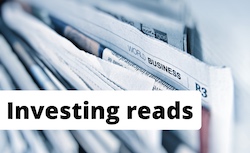I hadn’t heard of an ongoing investment club for many years before a long-time Monevator reader – and member of the Patrick Investment Club – dropped me a line. Such clubs were common 20-30 years ago. And as David Patrick’s guest article below shows, they filled a niche that today’s more impersonal and often abrasive social investing options hardly replace…
For more than 25 years my extended family has been pooling monthly subscriptions of at least £50 into the Patrick Investment Club.
This club has had a profound impact in helping us learn about investing. It has also helped bring us together as a family.
Such is the interest, these days we’re more likely to all meet for the Club’s AGM than for Christmas lunch!
Clubbing together
The Patrick Investment Club was established in 1998 by six family members. My three brothers and I – then in our 20s – and our parents in their late-50s.
The club has since doubled in size and now spans three generations.
We spent our early years pouring over library copies of the Financial Times and Investor’s Chronicle trying to understand company valuations. We felt oddly confident back then that we could identify companies destined to be the ‘movers and shakers’ of the future.
Sadly none of us identified any of the FAANGS, though we did have one multibagger success in Imagination Technologies.
There were a few dogs, too. One, Island Oil and Gas, disappeared beneath the seas – along with our shareholding.
These days – and with total assets in the low six-figures – we’re a little more cautious. Some 70% of assets are held in a global equity tracker and 30% in three sector ETFs.
Why start an investment club?
Back in the day our investment club, like many others, was set up to invest in companies and help us learn about investing.
At our inaugural meeting we adopted a constitution to govern how we operate.
We also opened a club bank account with Barclays and of course an investment trading account – currently with Hargreaves Lansdown.
One golden rule that has persisted in guiding all our investments was inspired by our pacifist teetotal mother: absolutely “no guns, no booze, no porn”.
So we apply an ethical SRI screen, though we don’t take too close a look at exactly what we hold within our funds.
The price of entry
Family members invest at least £50 each month. Some invest up to £200.
Monthly investments are automated and free through our investment platform.
The club is run with a light touch by the three officers: Chair, Secretary, and Treasurer. These roles have rotated over the years between family members with one – this writer – having been an officer for the whole period.
The club’s investment strategy is reviewed at each AGM. We offer each other commiserations on our under-performers and congratulatory back-slapping when we occasionally outperform our global benchmark.
Monthly statements set out the current value of members’ holdings, subs received and any withdrawals, along with the change over the last one, six and 12 months.
Holdings are unitised to take account of subs and ad hoc withdrawals. Brief commentaries are included, noting how the club’s performance compares to the MSCI World index.
A more virtual investment club
Other than at the AGM, engagement from members is low – though any miscalculations are quickly spotted.
Given the number of members involved and their locations – spread across Glasgow, Nottingham, and rural Wales – the AGM these days is usually a hybrid of face-to-face and video-conferencing.
In the early years the AGM was always in person. It was usually followed by a meal out or other social activity, too. One year we felt sufficiently flush to hire a barge for the afternoon.
Accounting activity
The absence of any tax benefits for investment clubs means that any dividend and interest income, however small, needs to be notified to members each April for inclusion in their tax returns.
Members have largely adopted a buy-and-hold strategy. Capital withdrawals are infrequent. There’s perhaps two or three a year among the 12 members. Typically these have been to pay an unexpected tax bill, fund a cruise, or contribute to a deposit for a new home.
In the early years a hardship fund was established to gift or loan members money during more challenging times. For instance, funds were occasionally requested to help tide a member over between jobs or to fund vocational retraining.
Fortunately such support has not been called on recently.
The evolution of an investment club
Reflecting back over the last 25 years, the club’s investing style has evolved through three phases.
We moved from investing in individual equities to focus on actively managed funds, and then to our current approach of investing in global passive ETFs – with a slant towards particular sectors that we feel will outperform.
For the first 15 years until 2013 the club was invested in individual equities. These included M&S, Tesco, WPP, Severn Trent and St James Place – as well as the dog and multi-bagger mentioned earlier.
The second phase began after a friendly financial advisor reviewed our portfolio and recommended a shift into actively managed funds and bonds.
Over the next six years we built modest holdings in, among others: F&C Corp & Ethical bonds, First State Global Property, Henderson Global Care, Impax Environmental Markets, Kames Ethical Fund, First State China Growth, Henderson European, Neptune US opportunities, Old Mutual UK Small Companies, and Aberforth UK Smaller Companies Fund.
These choices often mirrored personal holdings of club members, such as the nod towards China and environmental funds.
Lessons learned
In retrospect we had far too many holdings. However we learnt how funds worked, their charging structures, and how bonds were priced. We also began to better understand our own attitude to risk. We even offered members a choice between contrasting portfolios for a few years.
In 2019 we embraced another major shift – this time towards passive investing in a single portfolio. This was partly down to members’ own personal portfolios taking on more of a passive slant and partly due to the influence of Monevator.
Active funds were sold and we increasingly concentrated on just one passive global equity SRI ETF held with iShares.
Additionally one of our younger members had begun a career in wealth management. They put forward a persuasive case to slant our portfolio towards clean energy, automation and robotics, and global healthcare.
We duly invested 10% of our total assets in each of three passive ETFs – one per sector. Annual rebalancing happens in the spring, usually after the AGM.
Three years in and our sector bets combined have made us a loss, though Automation & Robotics helped to minimise this with a stellar 38% return last year. With our AGM looming we’ll soon debate whether to stick to these sectors or switch elsewhere.
Many happy returns
The club’s annualised growth over 25 years is 9.5%. This means £100 invested at start in 1998 would now be worth £338.
By comparison over the last 20 years the MSCI World index has risen by an annualised 11.9%.

Reflecting on the last 25 years, family members have seen a huge educational benefit from belonging to the club. We’ve learnt about the mechanics of investing, how different asset classes perform, and the risks associated with those assets.
With a larger membership including two juniors giving a greater spread of ages, we’ve increasingly had to reflect on the effect of differing time horizons on our investing style.
Risk appetites also differ between us. Members view their club holding as one modest part of their overall wealth. If they feel uncomfortable being 100% in equities, they can balance this with personal holdings in less risky assets.
There is always a lively debate at the AGM on our investing style. Some members argue that we don’t have an edge in spotting out-performers and therefore need to embrace low-cost passive investing.
Others espouse a broader approach. They argue for the club to speculate with a greater variety of assets including specific companies, currencies, and commodities, to provide us with hard-won skin-in-the-game experience.
Currently the wind blows in favour of a largely passive approach.
Perks for members
The Patrick Investment Club has had an interesting impact on family relationships. We learn from each other regardless of age and life experience!
Several of us have gone on to manage our own ISA and SIPP portfolios. And as mentioned above, one younger member is even pursuing a career in wealth management – having been inspired by the club.
The club has also helped with family cohesion. Often the only time we all meet – virtually or in person – is at the AGM.
The democratic nature of the club – one member, one vote – is sometimes challenging for those with larger holdings.
Overall our investing club has had a hugely positive impact on the family. Having already embraced several younger members, it’s likely to continue going for another 25 years.
Thanks to David for his engaging story. And my congratulations to his family for being so wholesome – I suspect organs would be lost in any such bartering among my own tribe. But what about you? Have you ever been a member of an investment club? Would it work with your family or friends? For me a major drawback would be the lack of a shared tax-efficient wrapper. Let us know what you think in the comments below…





![Decumulation strategy: first withdrawal, tax-free cash and drawdown antics [Members] post image](https://monevator.com/wp-content/uploads/2023/11/413.-decumulation-intro-copy-e1699404604796.png)